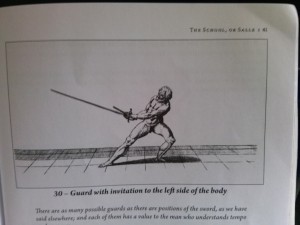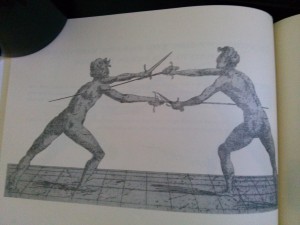In single rapier the sword divides the world into two halves, the inside and the outside. Attacks are generally described as being on the inside or outside line (with variants high and low, and at various angles). To cover these two lines, you have one weapon.
In sword and dagger you have a world divided into thirds: Outside the sword, outside the dagger, and between the two. Now there are two weapons for three lines, an improvement over one for two.
This is where standard SCA sword-and-dagger combat lets it sit – trying to guard three lines with two weapons.
Sport-style Sword and Dagger
Much of SCA dagger teaching includes a ”Don’t cross the streams” message: Don’t parry your dagger into your sword, or vice versa. This leads to a tendency to keep them separate, which results in dead space between the weapons where the dagger cannot easily guard.
The worst applications of this result in a tendency to hold the dagger extended like a buckler, with the torso very square, and try to windshield-wiper aside incoming shots, relying completely on the dagger for parries. Attacks often are a reach to pick up the opponent’s blade before launching an attack. The result is a very open guard, vulnerable on the center-line below the extended dagger, and along a line parallel with the opponent’s sword, as well as outside either weapon. If an incoming shot avoids the half-circle covered by the dagger (either by going close to the opponent’s sword, or parallel to the outside of the opponent’s dagger arm), a motion of the hand and the arm is required to make a successful defense. This is a slower motion than the attacker’s tempo of the hand to perform a cavazione – the smaller, fewer tempi will win.
Meanwhile, since the sword is not being used for defense, it’s often held out of presence so that it covers none of the fighter’s body, leaving the torso even more exposed.
Even fighters who hold the weapons closer together, but leave the center line open, must make a lateral motion from the shoulder for their parries. Said center-line is still vulnerable to angled shots that slip between the weapons or enter parallel to either (I favor a roverso squalembrato – descending offside – from guardia di testa – arm extended at shoulder height, sword angled upward and slightly forward to the left in front of the face – which drops into the dead space between the dagger and sword).
Giganti says of a guard with the center-line open they are, basically, good against less experienced fighters but “you should not use it against opponents who have an understanding of tempo and measure and who are equally skilled in the full-intent thrust and the feint.”
Joining the Weapons
Italian sword-and-dagger includes the concept of “joining the weapons.” It is a rejection of the “don’t cross the streams”axiom in favor of a union of weapons in space and in action. To start with, by holding them next to each other and angled together, the dead space no longer exists. There is no inside line. Instead of defending three lines with two weapons, two lines are defended with two weapons, one for each. By keeping the sword pointed at the opponent’s sword shoulder, it now covers half of the fighter’s torso, with the dagger covering the other half.
As mentioned, there is a high and low “line” on the inside and outside, so as a result the Italians have four dagger “parries” (which, since offense and defense are the same, also are the means of gaining the blade during an attack). The extension of the arms begins the motion, with the weapons and extending together. As always, the true edge is kept toward the opponent’s blade, but the sword goes to the opening (if the opponent’s blade went high, your sword goes low, and vice versa). The result is an attack parallel to the opponent’s blade and arm, and close-in, making it difficult for the opponent’s dagger to parry (at this point, if the opponent does try to cross the streams, it will actually keep the sword online for the kill). For the opponent’s sword to parry, the point must be brought off-line to cross your sword and be able to move it offline, thus stopping the attack (this attack in parallel to the opponent’s weapon or limb is called scannatura, or “throat-slitting,” by most Italian scholars).
The dagger rolls or slides either upward or downward to form a vertical barrier in the high or low line left open by the sword, ending with the wrists close together or the weapons close together. Rotating the torso away from the opponent’s sword strengthens the parry and also forms a void (see: Bodywork). The result is a wall of steel opposing the incoming shot while the sword counters into the opening. In illustrations some space is usually present between the wrists or weapons – once the parry is made the opponent’s blade is moved even further offline, resulting in this opening but only once it’s safe to create.
Any attempt to get around these defenses must take a large disengage, taking the blade off line and thereby ending the attack, or off-line step, a large motion to execute during an attack. Here’s where some more brilliance occurs: Note that in the guard pictured the arms are mostly extended, though angled downward. The remaining extension comes from lifting at the shoulders and leaning the torso forward. The dagger and sword are rotated into position from the shoulder as well. The elbows and wrists remain largely uncommitted, meaning the smallest, fastest body parts are still free to react to any possible counter action from the opponent – your counter is the smallest tempo in the fight (as opposed to the “sport” counter of significant shoulder movement).
Guards
Giganti describes the above guard, the invitation to the left side, as the best – it’s one of only three actual guards in his first manual (the other two are the invitation on the center-line, and see the quote above for his thoughts on that guard, and the invitation to the right shoulder). By giving only one opening, it forces the opponent to begin his attack on a known line, and his options from there are limited – your opponent starts in obedience. As mentioned in the bodywork chapter, this guard supports strong parries combined with voids. Adding in passing steps, especially on the outside, voids further and sets up the parry and the strike with almost no arm motion
Still, Giganti’s presentation is limited (partly because he intended his second book to be the more thorough treatment of sword and dagger, and then kind of half-assed it). Fabris takes the concept of joining the weapons and moving them into defense through footwork and bodywork only to something close to beautiful, beautiful insanity.

Fabris just showing off
The opponent can attack only under your swords here. Rotating the torso brings either your dagger across to close to the outside, or your sword across to close to the inside. Your opponent can disengage around your weapons, and would take a large motion to do so. However, you have yet to commit the arms and hands to an action, freeing them to then be used to counter a disengage. (While Fabris is squared up, which I criticized in regards to “generic SCA practice,” the forward bend deprives the opponent of access to the chest and really only places the head and shoulders in range – and they are behind the blades)
In each case, these are guards where the opponent has only one option of attack (and the possibility to disengage once your counteraction has begun, but again only to one line which you are easily able to counter).


Pingback: Dante di Pietro
Pingback: Ruairc